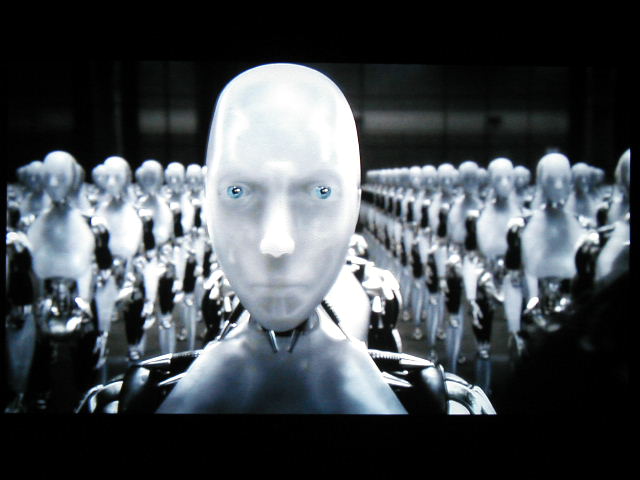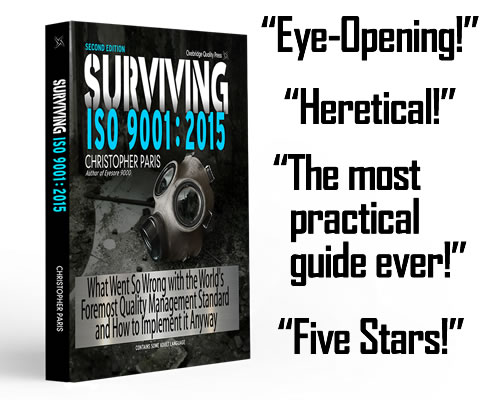 For all the evidence that TC 176 ignored the aerospace industry, one odd requirement seems to have snuck in, seemingly through aerospace intervention. You can’t tell because the requirement isn’t named as such, but it’s the “Human Factors” requirement from AS9110, the aircraft repair station QMS standard.
For all the evidence that TC 176 ignored the aerospace industry, one odd requirement seems to have snuck in, seemingly through aerospace intervention. You can’t tell because the requirement isn’t named as such, but it’s the “Human Factors” requirement from AS9110, the aircraft repair station QMS standard.
Never heard of it? Here’s a quick primer.
In AS9110, “Human Factors” (HF) are called out in section 6.4 Work Environment:
The organization shall determine and manage the work environment needed to achieve conformity to product requirements. The work environment shall give consideration to human factors and human performance, and ensure that the effectiveness of personnel is not unduly impaired.
The term is then defined in 3.1:
Human Factors: The study of human behavior (physically and psychologically) in relation to particular environments, products, or services and the potential effect on safety. Recognition that personnel performing tasks are affected by physical fitness, physiological characteristics, personality, stress, fatigue, distraction, communication, and attitude in order to ensure a safe interface between the personnel and all other environmental elements such as other personnel, equipment, facilities, organizations, procedures, and data.
Now, if you glance at 9001:2015’s clause 7.1.3 Process Environment you will find suspiciously similar language:
The organization shall determine, provide and maintain the process environment necessary for its operations and to assure conformity of goods and services and customer satisfaction.
NOTE Process environment can include physical, social, psychological and environmental factors (such as temperature, recognition schemes, ergonomics and atmospheric composition).
Without the Note, the clause is pretty much a reboot of our current clause 6.4. But with the Note, it suddenly jumps deep into HF territory. So how did this one aerospace requirement make it into 9001, when the rest of the standard so blatantly ignores everything else related to aerospace?
ISO 9000 — Yes, That One!
The answer is that it wasn’t an aerospace requirement. If we go back to ISO 9000:2000 — that’s the “Fundamentals and Vocabulary” document — we find that HF has sat unnoticed for the past 13 years. Here’s the definition of “work environment” provided by ISO 9000:
3.3.4 work environment: set of conditions under which work is performed
NOTE Conditions include physical, social, psychological and environmental factors (such as temperature, recognition schemes, ergonomics and atmospheric composition).
Then, looking at ISO 9004 (Managing for the Sustained Success of an Organization), we find more breadcrumbs:
6.6 Work environment:
The organization should provide and manage a suitable work environment to achieve and maintain the
sustained success of the organization and the competitiveness of its products. A suitable work environment,
as a combination of human and physical factors, should include consideration of
- creative work methods and opportunities for greater involvement to realize the potential of people in the organization,
- safety rules and guidance and the use of protective equipment,
- ergonomics,
- psychological factors, including workload and stress,
- workplace location,
- facilities for people in the organization,
- maximization of efficiency and minimization of waste,
- heat, humidity, light, airflow, and
- hygiene, cleanliness, noise, vibration and pollution.
The work environment should encourage productivity, creativity and well-being for the people who are working in or visiting the organization’s premises (e.g. customers, suppliers, and partners). At the same time, the environment complies with applicable statutory and regulatory requirements and addresses applicable standards (such as those for environmental and occupational health and safety management).
Now remember, neither 9000 or 9004 contain auditable requirements. What my insiders at TC 176 tell me is that under ISO 9001:2015 Working Draft 1, the usual definition of “work environment” was included:
The term “work environment” relates to those conditions under which work is performed including physical, environmental and other factors (such as noise, temperature, humidity, lighting or weather).”
But then, during the mad rush towards publication, someone swapped out that definition and stuck the ISO 9000 definition into Working Draft 2, which carried over unnoticed — because the WD2 was never vetted properly — into the ISO 9001 Committee Draft.
So someone took what had previously been an optional, advanced best practice of ISO 9004, defined in a non-binding ISO 9000 definition, and made it an auditable, mandatory requirement in 9001.
(Yes, I know it’s a “note” — but that doesn’t stop auditors from enforcing them.)
ISO 9001 Has You Stressed? Your HF Program isn’t Effective!
If you are still scratching your head over “HF” you’re not alone. Developed originally by the military for people working with “complex systems” and later adopted by organizations within suitably complex industries such as FAA aircraft repair stations, space vehicle design and nuclear power, it’s a complicated soup of disciplines, comprised of ingredients such as ergonomics, psychology, safety, environmental management, training, human resources and corrective action.
It doesn’t stop there. The application of HF is equally complicated, affecting multiple aspects of an organization, including:
- Work planning
- Facility and equipment design and planning
- Maintenance, repair and inspection of product
- Product design
- General management
- Training
- Work rules
When planning work, for example, factors such as the physical and mental fatigue of workers must be considered, while product design must consider the ergonomics aimed at the user of the product. Clearly not thinking ahead, the inclusion of HF in ISO 9001 would force companies to consider alternate methods of information transfer in order to reduce mental fatigue; this usually pushes companies to move to methods other than documentation, towards signs, illustrations, verbal instruction … you know, all those things that ISO has an allergy to, because they are not documented procedures. How do you control verbal instruction?
(I’ll have another article soon on how the 2015 revision continues to obsess over documents, even though they use different words to hide that obsession.)
So TC 176 set themselves up for a requirements crash, where one requirement will lead a user to contradict another. It took me all of ten minutes to figure this out… no one at TC 176 thought of this?
 Physician, Heal Thyself… Then Build a Rocket, Write an Opera and Make Me a Sandwich
Physician, Heal Thyself… Then Build a Rocket, Write an Opera and Make Me a Sandwich
Implementing HF under ISO 9001 will be hard, no question. HF professionals are one third OH&S expert, one third psychology major, one third EMS guru and one third professional trainer. Yes, that’s four thirds; it’s that complex. If you can’t multitask, go home.
Expenses will mount, too. Putting in an adequate HF program requires special training, and then implementation of what some have called a “shadow quality system” throughout the company, since it impacts on so many aspects and processes.
Next we have the fact that auditors, who will receive no training whatsoever on Human Factors, won’t know how to audit it. Like the process approach from ISO 9001:2000 or risk management under AS9100C, for the first year they will just ignore it. Then, as they get confident (or ANAB writes up somebody) they will come out guns blazing, but as uneducated as they were before they unholstered. Bogus nonconformities will be written, costing end user organizations more money as they scramble to fix nebulous, amorphous findings not really grounded in any firm requirement.
I mean, seriously, how are you going to assess if a company has provided the proper “social environment”? Even though it’s not what it means, I bet most auditors will be looking for evidence of a La-Z-Boy recliner in the conference room, complete with beer can sized cup holders in the armrests.
Simple Fix: Delete the Note
If the note under the proposed clause 7.1.3 is not removed, ISO 9001 end users are looking at a very grim, very expensive, and very complicated future. It’s not that hard things are not worth doing, but it’s just unfathomable how a concept normally reserved for nuclear power plants or the design of space stations landed in a standard which ISO is begging us to believe is equally applicable to any industry, including the elusive service industry.
Of course, you can always fire all your human workers and replace them with robots. Problem solved.
Christopher Paris is the founder and VP Operations of Oxebridge. He has over 35 years’ experience implementing ISO 9001 and AS9100 systems, and helps establish certification and accreditation bodies with the ISO 17000 series. He is a vocal advocate for the development and use of standards from the point of view of actual users. He is the writer and artist of THE AUDITOR comic strip, and is currently writing the DR. CUBA pulp novel series. Visit www.drcuba.world








